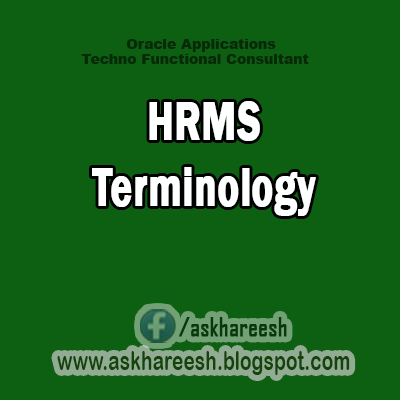
Electability : The process which determines whether a potential benefits participant, who has satisfied the eligibility rules governing a program, plan, or option in a plan, is able to elect benefits. Participants who are eligible for benefits do not always have electable benefit choices based on the rules established in a benefit plan design.
Element Classifications : These control the order in which elements are processed and the balances they feed. Primary element classifications and some secondary classifications are predefined by Oracle Payroll. Other secondary classifications can be created by users.
Element Entry : The record controlling an employee's receipt of an element, including the period of time for which the employee receives the element and its value.
Element Link : The association of an element to one or more components of an employee assignment. The link establishes employee eligibility for that element. Employees whose assignment components match the components of the link are eligible for the element.
Elements : Components in the calculation of employee pay. Each element represents a compensation or benefit type, such as salary, wages, stock purchase plans, and pension contributions.
Element Set : A group of elements that you define to process in a payroll run, or to control access to compensation information from a configured form, or for distributing costs.
Eligibility : The process by which a potential benefits participant satisfies the rules governing whether a person can ever enroll in a program, plan, or option in a plan. A participant who is eligible for benefits must also satisfy electability requirements.
Eligibility Profile : A set of eligibility criteria grouped together. Eligibility profiles help determine eligibility for compensation and benefits and are re-usable. Eligibility profiles can be linked to a compensation object (such as a program, plan, or option), a collective agreement, a grade ladder, or a work schedule to restrict eligibility for these.
Employee : A worker who has a direct employment relationship with the employer. Employees are typically paid compensation and benefits via the employer's payroll application.Employees have a system person type of Employee and one or more assignments with an assignment type of Employee.
Employee Histories : An SSHR function for an employee to view their Learning History, Job Application History, Employment History, Absence History, or Salary History. A manager can also use this function to view information on their direct reports.
Employment Category : A component of the employee assignment. Four categories are defined: Full Time - Regular, Full Time - Temporary, Part Time - Regular, and Part Time - Temporary.
Employment Equity Occupational Groups (EEOG) : In Canada, the Employment Equity Occupational Groups (EEOG) consists of 14 classifications of work used in the Employment Equity Report. The EEOGs were derived from the National Occupational Classification system.
Employment Insurance (EI) : Benefit plan run by the federal government to which the majority of Canadian employers and employees must contribute.
End Placement Date : DBI for HRMS uses this term to specifically refer to the contingent worker's most recent placement end date prior to the effective date.
Employment Insurance Rate : In Canada, this is the rate at which the employer contributes to the EI fund. The rate is expressed as a percentage of the employee's contribution. If the employer maintains an approved wage loss replacement program, they can reduce their share of EI premiums by obtaining a reduced contribution rate. Employers would remit payroll deductions under a different employer account number for employees covered by the plan.
Enrollment Action Type : Any action required to complete enrollment or de-enrollment in a benefit.
Entitlement : In Australia, this is all unused leave from the previous year that remains to the credit of the employee.
ESS : Employee Self Service. A predefined SSHR responsibility.
Event : An activity such as a training day, review, or meeting, for employees or applicants. Known as class in OLM.
Ex-Applicant : Someone who has previously applied for a vacancy or multiple vacancies, but all applications has ended, either because the applicant has withdrawn interest or they have been rejected. Ex-applicants can still be registered users.
Expected Week of Childbirth (EWC) : In the UK, this is the week in which an employee's baby is due. The Sunday of the expected week of childbirth is used in the calculations for Statutory Maternity Pay (SMP).
Extra Information Type (EIT) : A type of developer descriptive flexfield that enables you to create an unlimited number of information types for six key areas in Oracle HRMS. Localization teams may also predefine some EITs to meet the specific legislative requirements of your country.
